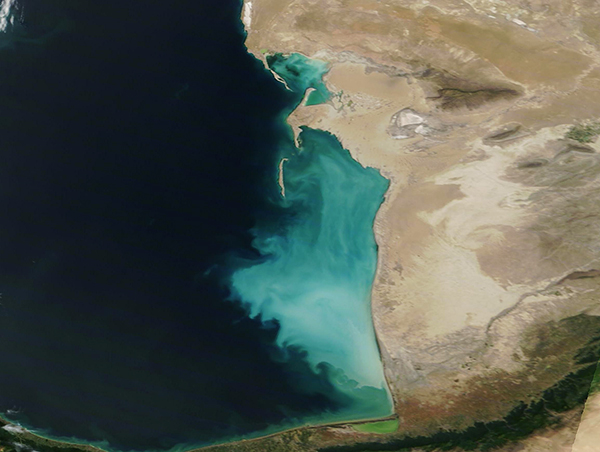Images
May 24, 2022 - Sediment in the Caspian Sea
Tweet
The Caspian Sea wins the prize for being the largest closed body on Earth, with a volume estimate at about 78,000 cubic kilometers and spanning a surface area of roughly 146,720 square miles (380,000 square kilometers). That’s a surface area larger than the country of Germany.
The Caspian Sea is sometimes divided into three parts, ecologically speaking. In the north, the sea is shallow, with a mean depth of only about 32 feet (10 meters), while the central sea deepens to 2,585 feet (788 meters). The deepest part of the Caspian Sea reaches 3,363 feet (1,025 meters) in the southern section.
Despite the deep water, the southeastern Caspian Sea just off the coast of Turkmenistan hosts a wide area of marine shallows, where the mud-covered bottom lies under a layer of water that stays less than 98 feet (30 meters). This coastal shelf stretches 124 miles (200 km) from north to south and 75 miles (120 km) from the shoreline into the sea. Beyond this shelf, the seafloor takes a deep plunge; however, the waters over the shelf are perpetually turbid as the ever-active wind stirs mud and sediment up from the shallows.
On May 23, 2022, the Moderate Resolution Imaging Spectroradiometer (MODIS) on board NASA’s Terra satellite acquired a true-color image of brightly-colored sediment in the Caspian Sea off of the coast of Turkmenistan. A small bit of the coast of Iran is also visible at the bottom of the image. The gorgeous color lies almost entirely over the shelf of marine shallows located in this section of the of the Caspian Sea.
Image Facts
Satellite:
Terra
Date Acquired: 5/23/2022
Resolutions:
1km (174 KB), 500m (422 KB), 250m (892.4 KB)
Bands Used: 1,4,3
Image Credit:
MODIS Land Rapid Response Team, NASA GSFC
Tweet
The Caspian Sea wins the prize for being the largest closed body on Earth, with a volume estimate at about 78,000 cubic kilometers and spanning a surface area of roughly 146,720 square miles (380,000 square kilometers). That’s a surface area larger than the country of Germany.
The Caspian Sea is sometimes divided into three parts, ecologically speaking. In the north, the sea is shallow, with a mean depth of only about 32 feet (10 meters), while the central sea deepens to 2,585 feet (788 meters). The deepest part of the Caspian Sea reaches 3,363 feet (1,025 meters) in the southern section.
Despite the deep water, the southeastern Caspian Sea just off the coast of Turkmenistan hosts a wide area of marine shallows, where the mud-covered bottom lies under a layer of water that stays less than 98 feet (30 meters). This coastal shelf stretches 124 miles (200 km) from north to south and 75 miles (120 km) from the shoreline into the sea. Beyond this shelf, the seafloor takes a deep plunge; however, the waters over the shelf are perpetually turbid as the ever-active wind stirs mud and sediment up from the shallows.
On May 23, 2022, the Moderate Resolution Imaging Spectroradiometer (MODIS) on board NASA’s Terra satellite acquired a true-color image of brightly-colored sediment in the Caspian Sea off of the coast of Turkmenistan. A small bit of the coast of Iran is also visible at the bottom of the image. The gorgeous color lies almost entirely over the shelf of marine shallows located in this section of the of the Caspian Sea.
Image Facts
Satellite:
Terra
Date Acquired: 5/23/2022
Resolutions:
1km (174 KB), 500m (422 KB), 250m (892.4 KB)
Bands Used: 1,4,3
Image Credit:
MODIS Land Rapid Response Team, NASA GSFC




